Smoking could be the reason why you can't fall asleep fast — health experts explain why
This Stoptober, we explore the effect tobacco has on sleep

You can buy the fanciest mattress and sleep tech in the world, but the hard truth is that you won't improve your sleep unless you kick your unhealthy habits.
While we all know that ditching caffeine and cutting down on sugar can vastly improve sleep, there is a certain legal substance that's rarely mentioned when discussing sleep health — even though 1 in 5 adults use it.
No, it's not drink, although alcohol can have a huge negative impact on sleep. We're talking about tobacco.
To raise awareness of tobacco's effect on sleep this Stoptober, we've talked to registered dieticians Jordan Hill at Live it Up and Kathleen Benson at Top Nutrition Coaching about the sleep disorders triggered by tobacco and how ditching it can help you fall asleep faster.
What is tobacco?

Tobacco has become synonymous with cigarettes, but what exactly is it?
"Tobacco is a natural plant known for having an addictive stimulant called nicotine," says health expert Hill. "It is commonly found in products like cigarettes, cigars, and chewing tobacco."
According to dietician Benson, tobacco is prepared for chewing or smoking by drying the leaves of the plant.
Get instant access to breaking news, the hottest reviews, great deals and helpful tips.
How does tobacco affect your sleep and why?

Tobacco's negative effect on sleep all stems from the highly addictive nicotine within the plant.
"Tobacco can cause sleep issues, especially when used within four to five hours of bedtime," explains Benson. "That’s because nicotine is a stimulant—it increases alertness and can make it harder to fall asleep or stay asleep through the night."
According to Hill, the stimulant can increase heart rate and delay the onset of REM sleep. "As the nicotine wears off over the course of the night, it can cause a withdrawal effect that may lead to lighter sleep and frequent awakenings," she warns.
Which form of tobacco use is worse for sleep?

While both smoking and chewing tobacco can make it harder to fall asleep, which is actually worse for your sleep health?
Both Hill and Benson agree that smoking is by far the worst form of tobacco use for sleep, even though other forms such as chewing and vaping also greatly disrupt sleep, due to the respiratory issues it causes.
"Smoking is typically the worst for sleep," Benson tells us. "Not just because of the nicotine, but also because it affects your breathing and may increase the risk of sleep disorders, like sleep apnea."
Hill also points out that smokers feel the stimulating effect of nicotine differently to other tobacco users.
"Smoking tobacco delivers nicotine to the bloodstream at a faster rate than chewing tobacco, leading to a quicker stimulant effect," she says. "Those who smoke also tend to be more at risk for insomnia and restless leg syndrome."
What happens to your sleep after quitting tobacco?

The good news is that ditching tobacco and quitting smoking can greatly improve your sleep, but the bad news is that it takes time to feel the benefits.
"It’s possible for sleep to worsen the first few weeks after quitting tobacco due to nicotine withdrawals," warns Hill. "Some symptoms experienced may include insomnia, night sweats, and vivid dreams."
However, Hill emphasises that after this period, sleep quality improves. "People who quit smoking tend to experience the benefits of falling asleep faster, having more deep sleep and longer sleep durations, and fewer awakenings," the health expert says.
Benson agrees, telling us how long you'll typically need to wait to see improvement. "It usually gets better within 3 to 4 weeks," reassures the nutrition advisor. "But talk to your healthcare provider if your sleep doesn’t start to improve."

Frances Daniels is a PPA-accredited journalist and Sleep Staff Writer at Tom's Guide with an MA in Magazine Journalism from Cardiff University. Her role includes covering mattress and sleep news and writing sleep product reviews and buyer's guides, including our Best Hybrid Mattress 2025 guide. She is interested in the relationship between sleep and health, interviewing an array of experts to create in-depth articles about topics such as nutrition, sleep disorders, sleep hygiene, and mattress care. She is also our specialist on mattress toppers — producing bed topper reviews and taking care of our Best Mattress Toppers 2025 guide — and leads content relating to fiberglass-free beds for a non-toxic sleep. Outside of Tom's Guide, she has written for Ideal Home and Marie Claire.
You must confirm your public display name before commenting
Please logout and then login again, you will then be prompted to enter your display name.
